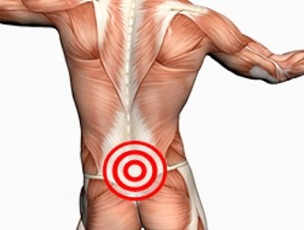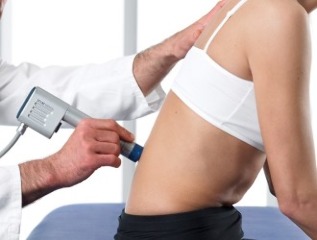
Lumbar osteochondrosisis one of the most common diseases of the spine.
It is characterized by the deformation of the cartilaginous tissue of the vertebrae.
The spine remains flexible and mobile as long as the vertebrae are healthy.
If the condition worsens, the intervertebral discs lose elasticity and begin to dry out.
As a result, patients develop severe pain in the lower back.
What is it?
When dystrophic-degenerative changes appear in the tissues of the vertebrae, they gradually begin to collapse. If the vertebrae located in the lumbar region suffer mainly, osteochondrosis of the lumbar spine is diagnosed.
Clinical presentation
In osteochondrosis, the cartilage tissue of the vertebrae begins to lose moisture, the elasticity of the intervertebral discs deteriorates. Over time, the height between the vertebrae decreases. Under increased load, the fibrous ring begins to crack, the intervertebral disc protrudes.This causes pinching of the nerve endings and the appearance of pain.
In the absence of adequate treatment, osteochondrosis progresses. The intervertebral discs harden, their cushioning properties deteriorate. Growths form in the bone tissue of the vertebrae, pressing on the nerve endings. Because of this, patients develop constant pain.
Grades and classification
Experts distinguish 4 degrees of spinal osteochondrosis:
- The process of destruction of the intervertebral discs begins, the symptoms of the disease are mild, a burning sensation, tingling, pain appears only after physical exertion. Patients talk about the appearance of dull back pain, sometimes radiating to the buttocks.
- The distance between the vertebrae gradually decreases and the annulus fibrosus begins to collapse. The intervertebral discs are compressed, they go beyond physiological limits, there is pressure on the nerve roots. Patients complain of tangible pain, which occurs in the buttocks, thighs and legs in the process of walking. In addition to pain, a burning sensation, coldness is possible.
- Fibrous rings are destroyed, during examination, intervertebral hernias are revealed in patients. Pain constantly bothers, regardless of the load.
- Bony outgrowths of the vertebrae are visible. The cartilage atrophies, the patient finds it difficult to move. As a result, the lumbar spine loses mobility and flexibility, and the patient is disabled.
| They classify osteochondrosis also by the type of course of the disease: | |
|
|
Experts distinguish the following period of osteochondrosis:
- debut;
- aggravation;
- referral;
- stabilization.
Treatment is selected based on the stage of the disease, the nature of the deformity, and the severity of the disease symptoms.
ICD 10 code
According to the international classification of diseases, spinal osteochondrosis has the code M42. Separately, there is juvenile (M42. 0), adult (M42. 1), and unspecified (M42. 9) osteochondrosis.
Prevalence and meaning
The lumbar region is more prone to the development of osteochondrosis than other parts of the spine. This is due to the increased load in this area, as it must support body weight. With a corset of weak muscles, the condition of the intervertebral discs begins to rapidly deteriorate, they are destroyed.
Very often, people over 30 yearssuffer from osteochondrosis of the lumbar spine. Although it can be found in younger patients. Almost 80% of patients who come to the doctor with complaints of pain in the lumbar region are diagnosed with osteochondrosis.
Examination of patients over 40 years of age revealed that most of them present characteristic changes in the intervertebral discs. But in the absence of clinical manifestations, a person is not considered sick.
In the absence of adequate therapy, the disease progresses. In neglected ways, it leads to the disability of the patient.
Risk factors and causes
Often, representatives of such professions meet with osteochondrosis: programmers, office workers, builders, movers, waiters and a driver.

Risk factors, in the presence of which the probability of developing osteochondrosis increases, include:
- being overweight;
- unhealthy diet;
- problems with posture;
- genetic predisposition;
- lack of sleep;
- frequent stress;
- constant hypothermia;
- needs to be in an awkward position for a long time;
- low physical activity.
The reasons for the development of osteochondrosis of the lumbar spine include:
- the body's natural aging processes;
- metabolic problems;
- back injuries;
- back problems;
- flat feet;
- vigorous physical activity, such as weight lifting;
- problems with the joints of the spine (rheumatoid arthritis);
- endocrine diseases;
- problems with the digestive and cardiovascular systems.
Some experts believe that the propensity to develop osteochondrosis is transmitted at the genetic level.
Consequences
A change in the cartilage tissue located between the vertebraeleads to a deterioration of the fibrous ring and the appearance of a hernia. Patients begin to complain of severe pain in the lower back, radiating to the muscles of the buttocks, thighs, and lower legs. But this is not the only possible complication of osteochondrosis.
Prolonged irritation of the spinal nerve causes inflammation.Patients develop lumbar sciatica.
With osteochondrosissciatica can develop(inflammation of the sciatic nerve). The disease provokes severe pain, numbness of the lower back, legs. Patients begin to walk, leaning to one side. This causes a greater curvature of the spine and a greater destruction of the intervertebral discs.
Osteochondrosis causes instability of the vertebrae. The lumbar region, under the influence of the weight of the body, begins to move from the sacrum. In women, such instability provokes the appearance of problems with internal organs (the uterus, ovaries, appendages suffer), in men - with potency.
When the intervertebral discsare destroyed, the blood supply to the spinal cord is cut off, the displacement of the vertebrae leads to compression myelopathy.
Cauda equina syndrome is considered the most dangerous complication. It consists of affecting the nerve roots. In severe cases, osteochondrosis causes paralysis of the lower extremities or paralysis of both legs.
It is possible to prevent the development of negative consequences if, when the first symptoms appear, you consult a doctor and do not ignore the need for treatment.
Symptoms
Osteochondrosis does not appear immediately. In the initial stages, the patient does not feel pain or discomfort. Complaints usually appear when the disease progresses to stage 2.
The main symptoms of lumbar osteochondrosis include:
- low back pain that worsens as the disease progresses;
- impaired mobility: problems appear when trying to bend over, roll over, the sensations when changing the position of the body are described by patients as "electric shocks", the pain in many of them radiates to the leg;
- change in the sensitivity of the limbs, which appeared against the background of damage to the nerve roots, in the affected area there is a burning sensation, numbness, tingling, tingling;
- muscle weakness, lack of tendon reflexes;
- local temperature drop;
- increased sweating;
- pale, dry skin in problem area;
- urination disorders, sexual dysfunction (in severe osteochondrosis).
Some patients have spasms of the arteries in the legs. But the symptoms are expressed only in the acute form of osteochondrosis. An exacerbation can start suddenly with hypothermia, uncomfortable movements, or after vigorous physical activity.
What doctor are you treating?
If you have back pain, you shouldsee an orthopedist and neurologist. The examination assesses the neurological condition of the patient, verifies how the spine performs its functions. Doctors also evaluate the condition of the muscles of the back and buttocks.
For experienced specialists, an examination is sufficient to establish a preliminary diagnosis. But to confirm it, the patient is sent for hardware diagnosis.
Diagnostic methods
The simplest and most accessible method to detect osteochondrosis isradiography. But to get a more accurate image, a computer or MRI is prescribed.
MRIallows you to examine the status of the column as precisely as possible. In fact, during the procedure, layer-by-layer photographs are taken of the problem area.
Treatment

The doctor selects the tactics of therapy based on the patient's condition, the stage of osteochondrosis and the clinical manifestations of the disease.
The doctor can prescribe:
- drug therapy, non-steroidal anti-inflammatory drugs, hormonal drugs, analgesics are selected;
- drug blocking, painkillers, hormonal drugs are injected into the affected area or the muscles located around the problem vertebra, which almost instantly relieve inflammation and eliminate pain;
- manual therapy, massage, physiotherapy, it is recommended after stopping the acute stage of the disease, with the help of physiotherapy, can enhance the effectiveness of drug treatment;
- medical gymnastics;
- acupuncture.
Operation required in advanced cases. Surgical intervention is prescribed in those situations in which conservative treatment does not produce the expected results.
Conclusion
With the progression ofdystrophic-degenerative changes in the cartilage tissues of the lumbar spine, osteochondrosis is diagnosed. In advanced forms, this disease can lead not only to the appearance of constant severe pain, but also cause paresis, paralysis of the lower extremities.
- You can suspect the development of osteochondrosis by the appearance of low back pain. With the progression of the disease, the pain increases significantly, the lower back loses its mobility.
- Depending on the degree of destruction of the intervertebral discs, there are 4 stages of the disease.
- This diagnosis is most often given to people after age 30. Almost 80% of patients who go to the doctor for back pain are diagnosed with osteochondrosis.
- People who lead an inactive lifestyle are susceptible to osteochondrosis, they are in an unnatural position for a long time, they experience frequent physical overload.
- The main symptoms of osteochondrosis are pain and reduced mobility of the lower back.
- Due to the destruction of the intervertebral discs in the lumbar spine, patients develop leg problems.
- If left untreated, pain increases,sciatica, vertebral instability, compression myelopathy can develop. In advanced cases, it paralyzes the lower extremities.
- In case of painit is necessary to consult a neurologist and orthopedist. The patient is referred for X-ray, CT, or MRI.
- Depending on the condition,is prescribed medications, blocks, massages, manual therapy, physical therapy, physical therapy exercises, or surgery.



































